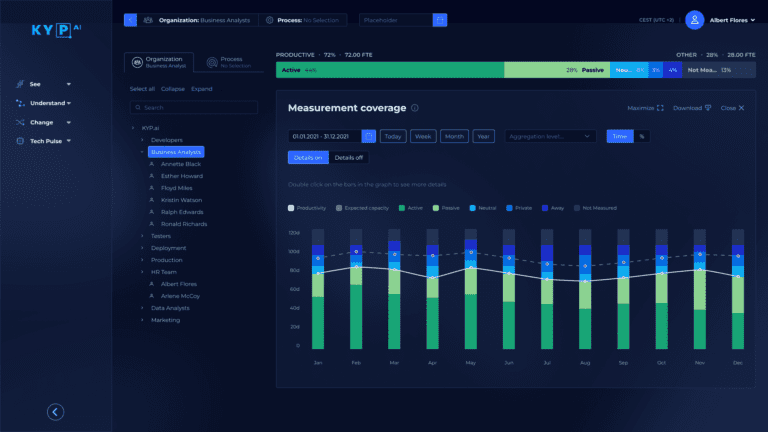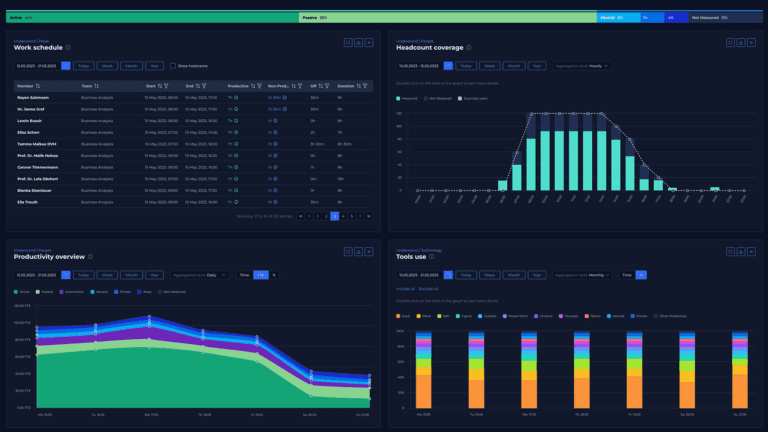When Good Processes Go Bad
Delays in shipments, approvals piling up, and hours lost to manual tasks: every team has faced these challenges. They slow things down, all while quietly impacting morale, customer experience, and performance.
The underlying root cause is centered around friction. It builds up over time, reducing visibility, increasing inefficiencies, and making even simple processes feel heavy. A well-defined business process automation strategy helps remove that friction. Eliminating repetitive work and connecting steps identifies how teams can improve speed, accuracy, and productivity.
This focused approach turns complexity into seamless flows and scattered tasks into structured systems. Automation without a clear plan often leads to more complexity, not less. That’s where KYP.ai comes in. We build real-time process intelligence to show precisely how work gets done and where automation will deliver the most value. The result is clarity, control, and measurable impact, all driven by data.
What Is Business Process Automation (BPA)?
Business process automation (BPA) uses technology to handle routine tasks and streamline workflows. Instead of filling out forms manually or waiting for email approvals, BPA helps move work forward automatically and accurately.
To do so, KYP.ai continuously shows you how work flows through your business. The data is captured behind the scenes, ensuring your team can work uninterrupted. BPA is then used to enhance your business outcomes by increasing efficiency, streamlining processes, and automating manual tasks.
As your business evolves and things get more complex, BPA adapts with you. This helps keep work manageable by making it repeatable and easy to track. Automation can help your teams add additional value by letting them focus on work that matters.
BPA vs. RPA: Clarifying the Confusion
Business Process Automation (BPA) and Robotic Process Automation (RPA) aim to boost efficiency and reduce manual work with different approaches.
RPA = Task Automation
RPA automates repetitive, rule-based tasks. Think data entry, form filling, or extracting info from emails. It’s fast, accurate, and perfect for high-volume, low-complexity work. However, it’s also expensive to set up and maintain. As processes change, so must the rules they follow. It can be a great option; however, you need a tool like KYP.ai to quantify the business case before you begin.
Typical RPA use cases:
- Copy-pasting data between systems
- Auto-filling and submitting forms
- Extracting values from PDFs or emails
- Logging into apps to perform repetitive steps
- Generating standard reports
RPA excels at task execution, but it can’t manage end-to-end workflows. This is where BPA steps in.
BPA = Workflow Automation
BPA takes a broader view, connecting tasks into end-to-end processes that apply business rules, manage dependencies, and ensure everything flows correctly.
Examples of BPA:
- Automating onboarding from form to activation
- Managing procurement across teams and tools
- Coordinating HR processes like hiring and payroll
- Integrating CRM, ERP, and communications platforms
- Triggering next steps based on business logic
Where RPA handles what gets done, BPA manages the how and why. Think of BPA as the system designer, and RPA as the engine running specific actions inside it.
Stronger Together, with KYP.ai
The most effective automation strategies are data-based and outcome-focused. By identifying areas of potential in your data and aligning them with your business objectives, you create a valuable AI pipeline. KYP.ai helps you create, track, and optimize your business. Using process intelligence, KYP.ai maps how work happens across your organization, identifying where RPA can save time and where BPA can transform workflows. You get data-backed insights, so every automation move drives real impact.
Key Benefits of BPA in the Modern Enterprise
A strong business process automation (BPA) strategy delivers measurable results. Here’s how:
- Operational Efficiency
Manual processes often create delays, introduce errors, and consume valuable resources. BPA streamlines these steps, enabling tasks that once took hours to be completed in seconds. Automated data synchronization reduces errors, eliminates bottlenecks, and allows teams to focus on higher-value, strategic work.
- Real-Time Collaboration
AI allows critical data to be shared instantly across teams. Stakeholders have access to up-to-date dashboards, enabling them to make faster, data-driven decisions. Approval workflows are accelerated, and department handoffs become more seamless and efficient.
- Stronger Compliance
BPA enforces compliance through built-in audit trails and automated approval checkpoints. Document retention policies are applied consistently and reliably, reducing the risk of human error and ensuring that regulatory requirements are consistently met.
- Enhanced Customer Experience
Efficient internal processes lead to better customer outcomes. Faster response times, consistent service delivery, and fewer mistakes all contribute to a more positive and reliable experience, ultimately building trust and fostering long-term loyalty.
Strategic Framework for Crafting a BPA Roadmap

Implementing Business Process Automation (BPA)unlocks an innovative, scalable roadmap. This framework helps you start strong, scale effectively, and stay agile.
Step 1: Identify the Right Processes to Automate
Use solutions such as KYP.ai to uncover your most time-consuming, repetitive tasks—the pain points slowing your teams down. Process mining or AI-powered analytics can track usage patterns, bottlenecks, and high-volume workflows.
Use the data to understand:
- How frequently do processes run?
- How many errors or rework occur?
- Are you compliant with your SOP(s)?
- What’s the potential impact of improving it—cost savings, time reduction, or improved quality?
Focus on high-frequency, rule-based processes that offer quick wins and/or compounding value over time. By building the business case before you take action, you can prioritize the BPA efforts that align to your strategic business goals..
Step 2: Ensure High-Quality Data Before You Automate
Successful automation begins with accurate and consistent data. If your systems are filled with incomplete or inconsistent records, automation can magnify the problem instead of solving it.
Start by:
- Standardizing data formats across your CRM, ERP, spreadsheets, and document systems
- Applying consistent metadata tagging, especially for document-heavy workflows
- Building inheritance logic to follow the steps of a process using its business context.
With platforms like KYP.ai, you can automatically capture digital interactions, tracking every click and data handoff. It highlights where data quality breaks down and helps you clean and standardize it before automation takes over.
Step 3: Select the Right BPA Tools and Platforms
Not all automation platforms are created equal. The best tools are intuitive, scalable, and ready for tomorrow’s complexity.
Look for:
- Low-code/No-code interfaces: Empower business users to build and adjust workflows without needing deep IT expertise
- Strong API integrations: Ensure seamless connections with your existing CRM, ERP, and productivity platforms, also consider integration with legacy systems
- Scalable, cloud-based infrastructure: Grow without limits, while keeping security tight
- Built-in AI capabilities: Enable more intelligent routing, anomaly detection, and predictive insights
KYP.ai offers a platform that combines all of the above—powerful yet user-friendly, and flexible yet secure.
Tips for Smooth Implementation and Adoption
Even the best business process automation strategy needs effective execution. These best practices ensure adoption and long-term success:
1. Train and Empower Your Teams
Automation should be framed as an opportunity. Help your teams see how it frees them from repetitive tasks and opens doors to more meaningful work.
- Use real-life scenarios in training sessions.
- Provide hands-on experience with the tools.
- Offer ongoing support and recognize innovation.
When teams understand the value and feel supported, adoption comes more naturally.
2. Drive Cross‑Functional Collaboration
Automation isn’t an IT-only initiative. Involve stakeholders across departments—IT, operations, finance, HR, and customer service.
- Host workshops to map out current priorities
- Identify inefficiencies and potential automation areas.
- Encourage shared ownership of the automation roadmap.
KYP.ai makes this easier by automatically mapping journeys and uncovering opportunities, so teams collaborate with clarity.
Select platforms that support citizen development, enabling non-technical users in HR, finance, or marketing to prototype solutions without relying on IT.
3. Monitor, Optimize, and Iterate
Going-live isn’t the finish line; it’s the starting point.
- Track performance metrics like cycle time, error rates, and compliance adherence
- Use AI to continuously uncover new automation opportunities.
- Review and update your BPA roadmap regularly to align with shifting business goals.
Automation is a journey. The more you refine, the more value you unlock.
What’s Next: Emerging Trends in BPA
Business Process Automation (BPA) is quickly evolving. It’s no longer just about speeding up routine tasks but transforming how work gets done. Here are the key trends shaping the future:
- Intelligent Automation with AI and Machine Learning
Traditional rule-based automation gives way to intelligent automation powered by AI and ML. Systems now go beyond “if-this-then-that” logic—they can interpret documents, detect anomalies, and dynamically adapt to real-time changes.
Use case: A support ticket can be automatically routed based on the urgency, tone, or sentiment of customer feedback, eliminating the need for human intervention when it’s unnecessary.
This shift enables more dynamic and responsive workflows that handle complexity with ease.
- Hyperautomation
Hyperautomation combines BPA, Robotic Process Automation (RPA), AI, and process mining into a unified approach. It aligns these approaches to automate entire workflows across departments and systems.
With intelligent orchestration of people and technology, businesses can:
- Automate end-to-end processes
- Reduce manual intervention
- Optimize operations in real time.
Hyperautomation is the engine behind full-scale digital transformation.
- Democratization of Development
Low-code and no-code platforms make automation accessible to everyone, not just IT.
Business teams in HR, finance, and marketing can now build, test, and deploy automations tailored to their own needs. This leads to:
- Faster implementation
- Reduced IT workload
- Greater innovation at every level of the organization
- Boosted productivity and higher employee satisfaction
Empowered teams move faster and bring more impactful ideas to life.
Automation means accelerating. Forward-thinking organizations embrace these trends and build flexible, scalable BPA strategies to stay ahead.
Conclusion: Start Smart, Scale Fast
Business Process Automation is a long-term mindset.
Start with clarity. Define what success looks like: faster turnaround times, fewer manual errors, more satisfied employees and customers; the choice is yours. Ensure your data is orchestrated to build a solid foundation. Choose automation tools that can grow with your business.
Empower your people. Bring teams together to build the roadmap, pilot improvements, and continuously refine them.
With KYP.ai’s process intelligence platform, you gain deep insight into how work happens. You see the hidden friction, design more intelligent workflows, and drive meaningful business results.
Ready to transform? The roadmap is clear. The opportunity is real. And it starts with a strategic approach to BPA that scales with you and for you.
FAQs
1. What’s the difference between business process automation (BPA) and robotic process automation (RPA)?
While RPA focuses on automating specific repetitive tasks like data entry or system updates, BPA streamlines entire workflows and processes across departments. Essentially, RPA is one of the tools used within a larger business process automation strategy.
2. How do I identify which processes to automate first?
Start by discovering highly repetitive, rule-based, and time-consuming workflows. Use AI-driven insights, like those provided by KYP.ai, to identify inefficiencies, error-prone areas, and opportunities where automation will bring the highest time and resource savings.
3. Do I need to clean up my data before automating workflows?
Yes, clean and consistent data is crucial before implementing any automation. Particularly, if your process is not optimized, automation will only replicate existing issues at a faster and larger scale, rather than solving them. Tools like KYP.ai help you first improve, then optimize with AI or automation.
4. How do I choose the right BPA platform?
You should choose a platform that aligns with your business objectives. Look for solutions that support low-code or no-code capabilities, integrate easily with your existing systems, and provide AI-powered insights to guide ongoing optimization.
5. What are some common mistakes to avoid when implementing BPA?
Common pitfalls include automating inefficient processes without optimizing them, skipping user training and change management, and failing to analyze and improve workflows after they are launched. A successful automation journey is always iterative and helps you to achieve more.
Discover Your Productivity Potential – Book a Demo Today
Book Demo








